Meet George and Gracie, Long Island’s Most Adored Couple
Please be advised that nature can be brutal – viewer discretion is advised. Tip: Use the red scroll bar to rewind the stream up to 4 hours
Wondering why the screen is cloudy right now? Click here for a video highlight. Please pray for rain and a little East Wind!
Special Thanks to Tommy: George & Gracie’s Landlord
Recent Highlights
IMPORTANT: Messages from osprey experts
I haven’t seen the little guy yet this morning, but I would be very surprised if he survived the night. That sure was tough to watch yesterday, but that whole process is as much a part of the essence of being an Osprey as is eating a fish. It’s part of the life of Ospreys that was rarely seen before we started putting cameras in nests. As hard as it is, we should not label the behavior as mean or cruel. Being mean or cruel implies that there is intent to do harm just for harm’s sake. Those young were responding to a set of stimuli (very little food being delivered to the nest and the presence of a very small young) in a way that evolution has hard-wired into them. It helps ensure their survival. Nature is not cruel. It is harsh, unforgiving, and often random (had the little guy been born 1st, he would have been just as aggressive as was his sibling), but not cruel or mean.
 Paul Henry ospreyzone July 1, 2015 at 8:17 am
Paul Henry ospreyzone July 1, 2015 at 8:17 am
Thanks Rob for bringing your knowledge and experience to help us all gain perspective here. We are all saddened by the events that unfolded before our eyes and it’s only natural for all of us to feel and express our emotions appropriately. There have been many issues pertaining to intervention which have been discussed amongst us all. There is no doubt in my mind that the right decision was made, to let nature take it’s course. By the way, that doesn’t equate to heartless, on the contrary, nobody feels worse about this then the apparent decision makers. I say apparent, because when all was said and done, and all the issues were properly weighed, there really weren’t any other options. It was clearly pointed out, by experts, that intervening at this stage could have spooked the whole nest to the point of losing all the young. If the little one was saved, and nursed back to health, what kind of a life would it have had, perhaps caged up in a zoo. I remember when I was younger I saw a golden eagle in captivity, caged behind a wire mesh. I could practically see it’s tears. As far as placing the little one in another nest, such a low probability of success would never have justified the possibility of spooking the nest. There’s a piece of me, however heavy hearted, that believes that perhaps it is better to be born free and die free. We mourn for the little one as we marvel at the wonders of nature.
Hello Paul,
Thanks for your query, and you have my admiration for persevering. We know very well how tough your job is, including dealing with an anxious public.
Our policy with our Bird Cams project is essentially “just say no” to pleas for interference. The behavior you are witnessing – while seemingly cruel and heartless to us – is natural for many kinds of birds, especially those that feed on variable, unpredictable food supplies. The little nestling does have a chance to survive, but if it does not then that result was “meant to be” by the nature of Osprey breeding strategy. The wonderful things about these nest cameras also sometimes yield the difficult things for us to watch. As you might know, we actually post a “siblicide alert” on some of our cams where we suspect the possibility exists.
I’m copying your note to Charles Eldermire, project leader for our Bird Cams. He may have some additional comments, and he would be the one to ask if we might be able to use your stored files for biological analysis.
Best wishes, and good luck,
John W. Fitzpatrick
Director, Cornell Lab of Ornithology
It’s also important to acknowledge that intervening can also cause problems of its own—depending on the ages of the birds in the nest, disturbing them can trigger an early fledge. We have restricted the scenarios in which we would even consider intervening to injuries or dangers that are explicitly human-derived. For example, 3 or 4 years ago we were alerted by viewers that one of the osprey chicks at the Hellgate Osprey nest was entangled in monofilament line. We consulted with our partners there (wildlife biologists, raptor researchers, raptor rehabbers) to determine if the monofilament was an issue, and if intervening was both likely to solve the issue AND not have bad effects on the other nestlings. In the end, a quick trip to the nest was scheduled via a bucket truck, the monofilament was removed, and the nestlings all eventually fledged. In that case, all of the permits were already in hand to be studying the ospreys, and we had already discussed how to approach issues in the nest.
Good luck to the young one—hope it all turns out well.
charles.
*******************
Charles Eldermire
Bird Cams Project Leader
Cornell Lab of Ornithology
I’ve been to your site—great cam! And I noticed the runt in the nest. This is just normal Osprey reproduction. It happens all the time and you should not intervene. It’s tough to watch, but it’s how nature works. Ospreys almost always lay 3 eggs and on average fledge between 1 and 1.5 young each year. They stagger the hatch so there is a spread of ages in the young. That way, if food is short, the first-hatched (and therefore largest) will get enough food to survive while the smaller nest mates do not. If all three young were the same size and there was only enough food for 1 young, none of the young would get enough food and they would all die. If there’s lots of food, the smallest will eventually get fed and can survive. These nest cams can show some gut-wrenching scenes. The most infamous perhaps was one of the very first Osprey cams (on Long Island somewhere), where the smallest young died. One of the adults carried it out of the nest and after several minutes flew back into the nest and fed it to the other young. Waste-not-want-not at its goriest. At Hog Island up in Maine just last week a Bald Eagle came in and took the young out of the nest. Last year at another nest, cameras documented a Great-horned Owl taking young Ospreys out of a nest in NJ or MD. All of these things have been going on for millions of years and Ospreys are doing fine.
Rob Bierregaard
Academy of Natural Sciences
Drexel University
http://www.ospreytrax.com

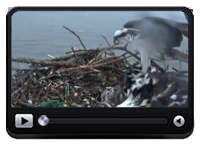
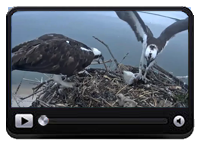
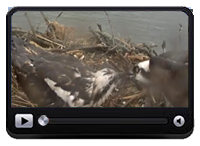

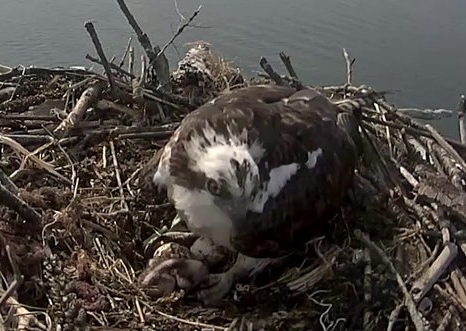
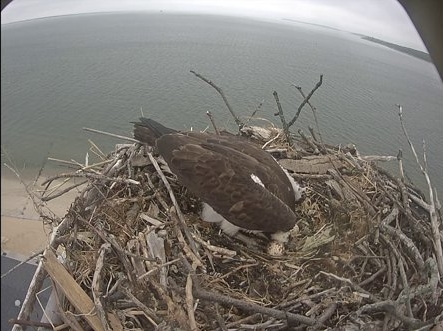
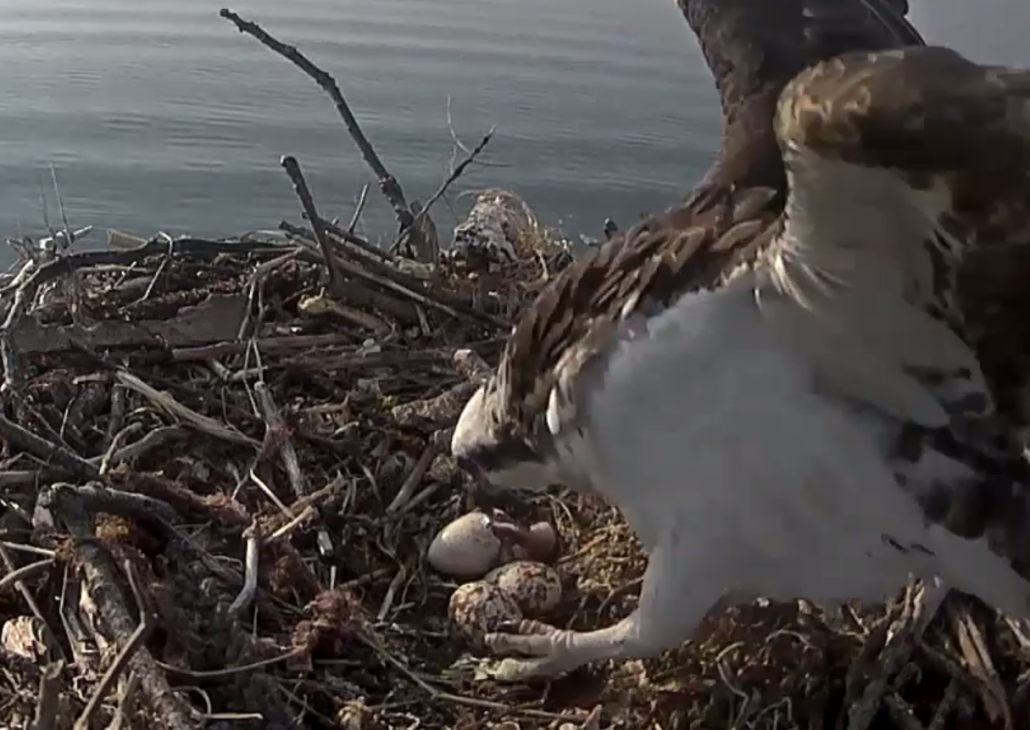
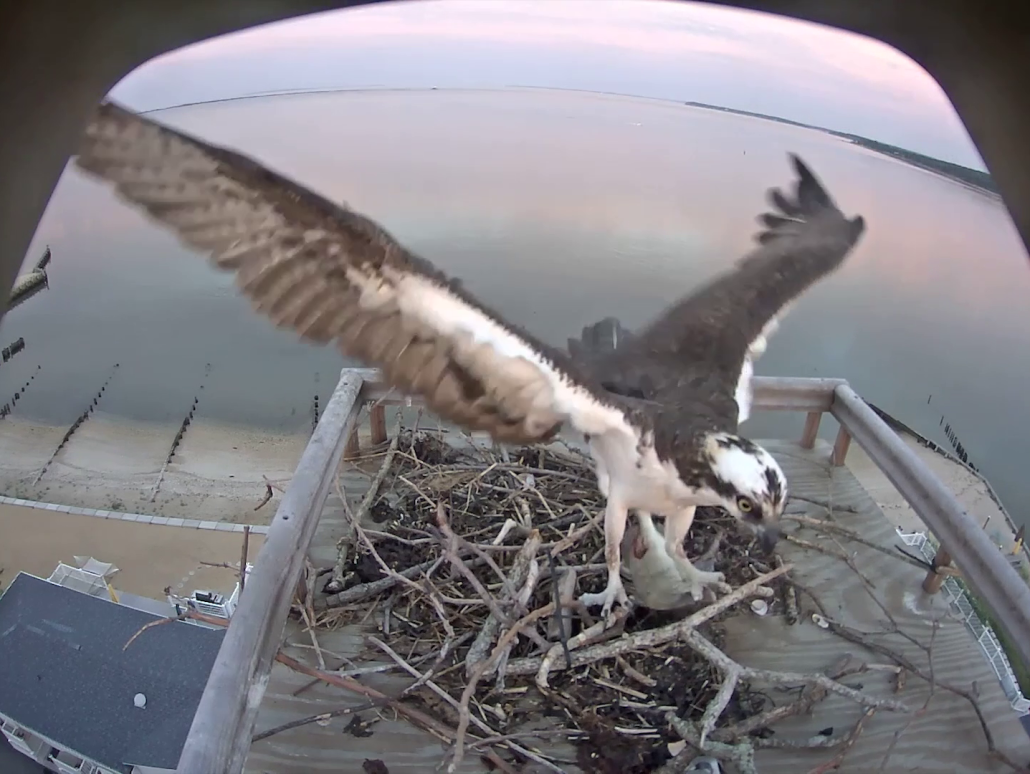
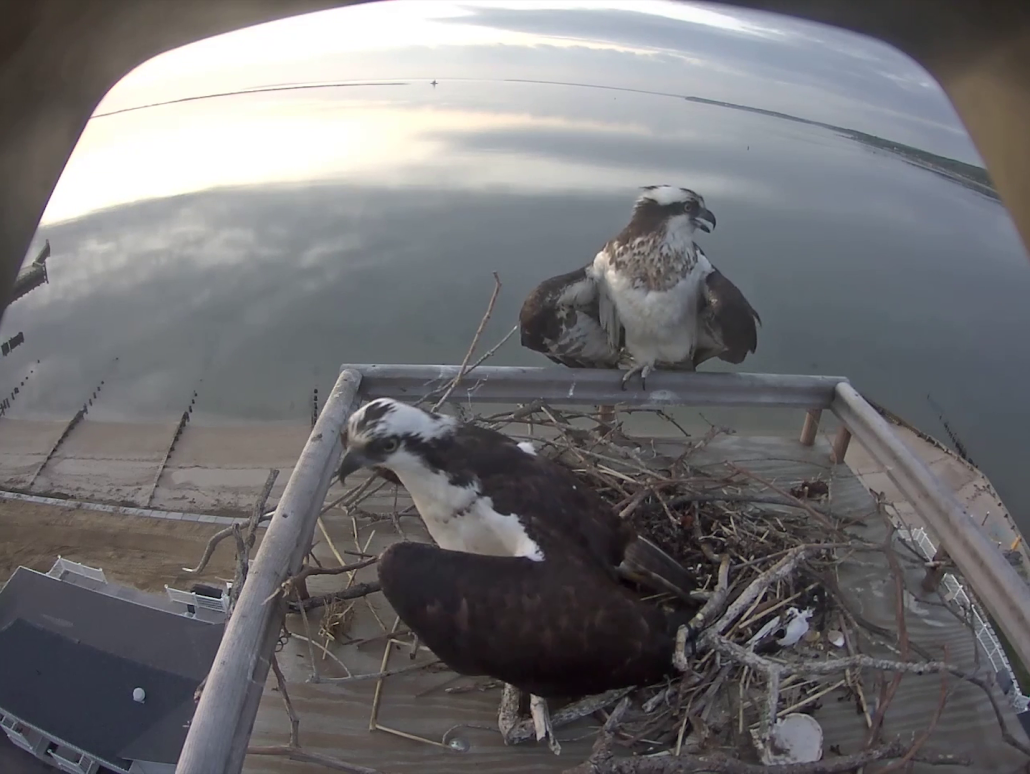

Hi to all… miss everyone! Is summer flying by for you , too?
At the last feeding, babies didn’t seem too hungry. Good for Gracie, she gets more to eat.
At first I did not like the smaller picture ( i am on a very small laptop ) but I’ve been sitting here watching… The view is closer and sharper… We can see more detail… I think I like this better……. Also, I’ve been wondering… Paul, do you have an address we can send small donations to that maybe we viewers can help pay for new cameras or more nest sites and maybe help spread awareness of these beautiful creatures?
I am amazed at how big the babies have grown! When are the names going to be decided for these three babies. Thank you for providing all of us with a window into George and Gracie and their beautiful family!
Lunch and the babies were hungry.
As many of you have noticed, most of the comments have disappeared from the page. The comments did not get deleted, it is simply the page navigation that is missing. All the old comments still exist, so we will try to correct the problem as soon as we can.
Thanks Paul for your ongoing effort keeping everything running for the viewers. I noticed that the poop stains on the camera window have dried in a way to enable at least a little viewing. Wish there were a way to send a jet stream of water up there to wash it off though.
signed on to see all comments………nothing yet
Have all the comments disappeared?
No problem. All better now.
What’s happened to the site. Screen is blank.
Poor Gracie. She seems exhausted. Closed her eyes for a minute and almost fell over. She seemed very nervous earlier looking up and over the nest and yelling.
1:00pm Gracie is giving us a birds eye view today making up for us not being able to see through the camera lately. She is so beautiful with her feathers blowing in the wind Must be really hot the birds are doing a lot of panting and they say they do that too cool their body down several times the babies try to take shelter under her wings
This is definitely an up close and perfect moment Gracee you got the spotlight your a star !
Babies appear to be very hot. Gracie is doing her best to try and provide some shade. and is also getting very up close and personal with the camera lens. I believe George is on the perch.
did the camera slide down? Grace is right in front and seems to be biting on it….
hi Paul…. where are the page numbers? I like to go back to comments i missed and see what’s been happening……
Paul, did you delete all the comment history from this area? it’s nowhere to be found now.
Seems to be something wrong with the comments, we’ll try to find out what happened
Quick question if you are viewing from a mobile phone where do you read the comments I enjoy catching up on the days events as I am unable to watch it all the time thanks for the help
Is there a tutorial explaining how a Mother Osprey teaches her fledglings to fly ?
I recall reading on a LIVE FEED for eagles where ( I think ) it talked about the Mother, somehow, taking the baby on her back, get altitude and suddenly ‘pull away’ allowing the baby to free fall……..and then the Mom scoops below the falling baby, catches it on her back………and continues the process until the baby ‘gets’ it
Does the Osprey follow the same methods ?
From what I have read, the babies get very little help from their parents, and learn to fly mostly from their own instincts They start by trying to “jump” across the nest. I guess we will find out for ourselves in the next few weeks!
Did we lose the page back feature?
Was just checking out the new highlights feature! Thank you! It was fun to see the chicks so early on. I only started watching right before Peewee passed, so I missed the first stages. You can see he was so much smaller from the beginning. RIP little guy.
Where are the rest of the comments?? That is usually how I see what is going on?
Samantha thanks for signing the petition. I to have never signed a petition before After becoming a devoted live cam bird fan I felt I really should do this. I have learned so much. This is only my 2nd year watching the ospreys
First year with osprey zone. However I have two osprey nest here in Florida near my home that I watch but cannot get no where’s near the view as I’m getting on the losprey live cams. I just kept thinking what if my one signature could be the remaining factor to stop all these killings I couldn’t live with the guilt once Audubon sent this petition to me so I had to do it. Thanks again and here’s to a beautiful day and hopefully the camera lens will get clear as time goes on . My eyes are going bad but I can’t get enough of my Osprey family so I continue to leave it on even though half the time I’m squinting
What happened to all the previous comments?
We are starting to post the highlights of each day on the side of the live stream window.
I would love to see a highlight of the June 23rd storm.
Love seeing the highlights. I had forgotten how small the babies were.
thank you! i just noticed that and like that! Now i will know if I missed something super news worthy! also thank you for all you do to allow us to see Gracie, George & babies.
Happy Four-Week-Old birthday to number one chick today!
Birthdays:
Chick 1: June 12, 2015
Chick 2: June 13, 2015
Chick 3: June 15, 2015 (RIP little fella)
Happy Birthday, Gigi. 🙂